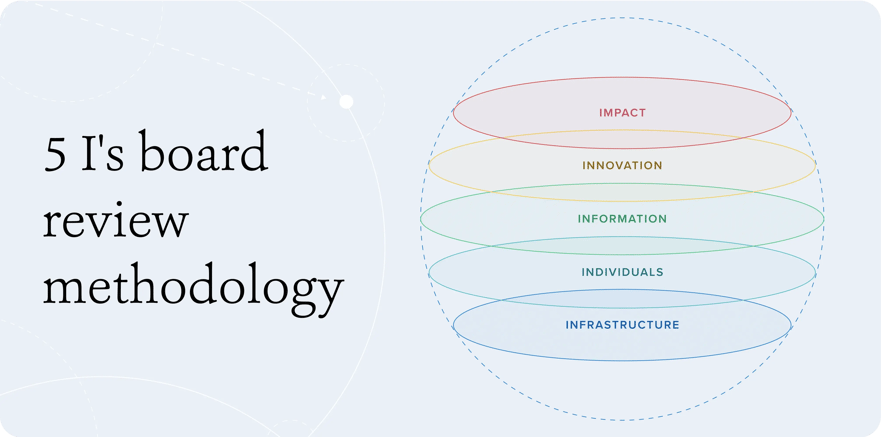According to a PwC survey, 74% of directors believe that board evaluations are an effective way to enhance board performance. Yet only 58% made changes to board practices following an evaluation. Effective planning, relevant processes, and board engagement are all key to identifying practical actions that will make a difference.
If you’re wondering how to evaluate board performance in a way that delivers both measurable results and meaningful impact, this guide will take you through each step of the process.
What is a board evaluation?
A board evaluation is a formal assessment of a board’s performance and effectiveness. The aims of a board evaluation are to:
-
Assess the impact of the board.
-
Better understand the drivers of board performance.
-
Ensure the board is aligned with the organisation's goals.
-
Identify strengths and opportunities for development.
-
Manage potential risks and ensure compliance.
-
Create a culture of accountability and transparency.
-
Ensure the board has the right skills to navigate challenges.
-
Promote continuous improvement.
Why do we evaluate board performance?
Regular board evaluations are often a requirement of local listing rules or corporate governance regulations. The G20/OECD Principles of Corporate Governance, for example, state that boards should “regularly carry out evaluations to appraise their performance and assess whether they possess the right mix of background and competences.” Conducting regular board reviews helps organisations to meet compliance requirements and demonstrates accountability to shareholders, regulators, and other stakeholders.
Beyond compliance, board evaluations are a practical way to assess whether the board is working as it should — and an essential tool for high-performing boards and good governance.
An evaluation highlights what’s effective and where there’s room to improve, whether that’s in decision-making, oversight, or the balance of skills around the table. It gives boards the chance to step back, reflect on their performance, and adapt to changing business needs.
Done well, board reviews also encourage more open conversations between directors about their contribution and effectiveness. They give board members a clearer understanding of what is expected and encourage directors to take ownership of their performance and impact.
In this way, evaluations strengthen governance, build trust, and support long-term organisational success. Without them, boards risk losing focus and falling short of the standards expected of modern leadership.
To ensure the board fulfils its responsibilities, it is essential to know how to evaluate board performance and to do so regularly. It is also vital that these evaluations generate meaningful insight and lead to relevant recommendations, so that boards can continuously improve their performance and enhance their impact.
They also recognise that different challenges require different approaches. From onboarding new directors to deep dives on critical risks, upskilling is viewed as a multi-year journey that evolves with the business.
What are the types of board evaluations?
Evaluations can take several forms, but the biggest point of difference is whether the evaluation is internally led or externally facilitated.
Another variable is the scope of the review; evaluations can focus on the board, but can also cover committees, individual board members, and the chair. They can also be conducted at group and subsidiary level.
Board evaluation options include:
- External evaluations: facilitated by an impartial third party.
- Self-assessments: board members assess their own performance and that of the board.
- Peer-to-peer evaluation: board members anonymously evaluate each other’s performance.
- Executive director evaluation: the CEO or executive director reviews the performance of the board.
Read on for an overview of the key guidelines on how to conduct a board evaluation. This includes when to conduct an evaluation, which areas to review, whether to conduct an internal review or facilitated external evaluation, and what to do once you’ve gathered all the evaluation data.
When should you conduct board evaluations?
The frequency of evaluations will depend on your organisation's needs, specific events within the organisation, and local listing rules or corporate governance requirements.
-
Annual evaluations: A yearly evaluation helps identify and mitigate potential issues before they start causing problems.
-
Biennial/triennial evaluations: A comprehensive evaluation, ideally conducted by an objective third party, every two to three years provides an opportunity to ensure the board is aligned with longer-term strategy and addressing long-term issues.
-
Event-triggered evaluations: Boards may choose to conduct an evaluation during a time of significant change (like a merger or regulatory update), following a change of chair, or at an inflexion point of strategy.
How do you plan your board evaluation?
Thorough planning is required to conduct a successful board evaluation. This includes defining the purpose of the evaluation, setting the scope of the review, and choosing the evaluator. You’ll also need to choose the method and tools you’ll use to conduct the evaluation.
Setting clear objectives
When setting goals for a board evaluation, think about what success looks like and how you will know if you’ve reached it. Is it by:
- Setting something in motion i.e. implementing a solution?
- Measuring the impact that a solution has had by soliciting anecdotal feedback from your board?
- Quantifying the impact on your board as experienced by management and/or external stakeholders?
However you decide, the key is to define success. Without a goal, your development plan will have less chance of making a difference. Ideally, you should also identify a small number of relevant metrics and report on these regularly to help you monitor progress.
How do you choose between internal vs external evaluations?
Once you’ve established your goals for the evaluation, you’ll need to decide who will conduct it. Will the board members assess themselves and each other, or will an external party handle the process?
Internal and external evaluations each offer advantages.
| Benefits of internal evaluations |
Benefits of external evaluations |
|
Cost-effective, no need to hire external advisors. |
External consultants bring experience with your peers and fresh perspectives. |
|
Can be implemented quickly. |
Feedback can be more thorough and unvarnished, helping to uncover ‘blind spots’ and challenges. |
|
Internal evaluators are familiar with the organisation’s culture and processes. |
Easier to deliver difficult messages. |
|
Recommendations can be more innovative, drawing on outside best practice. |
|
|
Can enhance the board’s credibility with stakeholders. |
For publicly listed companies in many jurisdictions, regular facilitated board reviews are a requirement of local listing rules or governance codes. Outside of this requirement, they can be particularly beneficial for companies where the board is facing significant challenges or where there’s been a recent change of chair, for example. Many companies opt for an external review every three years, with internal self-assessments in each of the years between those reviews.
As Helle Bank Jorgensen, experienced board reviewer and head of Board Intelligence’s board development practice puts it: “The best evaluations create a space that’s honest and brave, where directors feel safe enough to speak candidly and curious enough to listen differently” (watch our interview with Helle to find out more).
It’s also important to consider exactly how the evaluation will be conducted. The process may include questionnaires, interviews, board meeting observation, and/or group discussions. It could also include an analysis of meeting agendas, board papers, and meeting minutes.
Using a board portal can help streamline the process, by making it easier to store, access, and analyse important board documents. In addition, tools like Agenda Planner from Board Intelligence can provide useful data to support your analysis – for example, allowing you to analyse how your board spends its time and the extent to which certain stakeholder groups are considered within board meeting agendas.
Using a digital board survey tool
Questionnaires or surveys are commonly used to support board evaluations. They can be the primary means of gathering information for an internal review and can provide external evaluators with valuable insights to guide their planning.
When considering a digital board survey tool, it’s important to look out for the following features:
-
Ease of use: the platform should be intuitive for both administrators and directors, with minimal training required.
-
Customisable templates: pre-built surveys tailored to governance best practice, with the flexibility to adapt questions to the board’s context.
-
Confidentiality and security: strong data protection measures to ensure directors feel comfortable providing honest feedback.
-
Trend analysis: the ability to compare results year-on-year.
-
Actionable reporting: clear, visual reports that highlight trends, strengths, and areas for improvement.
-
Automation: features that enable governance teams to manage survey requests, reminders, and submissions.
-
Accessibility: mobile-friendly and available across devices to encourage higher response rates.
-
Reporting: options to export or integrate results with board portals or reporting tools.
-
Resources: additional tools and insights to inspire your development plan.
A good board survey tool should go beyond data collection, turning information into practical insights that can be used to improve board effectiveness.
Key areas to evaluate
The evaluation should focus on the key drivers of board performance, including the way they make decisions, the way board members interact with each other. It should also assess the board’s impact – whether it enables the organisation to create sustainable long-term value and its role in growth and innovation.
When you’re looking at how to evaluate board performance, Board Intelligence’s 5 I’s framework provides a helpful starting point:
-
Individuals: board composition, leadership, and culture
-
Information: board pack - quality and coverage
-
Infrastructure: governance processes, decision making, and meeting effectiveness
-
Impact: the board’s areas of focus and engagement with strategy
-
Innovation: the board’s role in innovation and external views
This framework assesses boards and committees against the three traditional pillars of board effectiveness: individuals, information, and infrastructure. It also focuses on two additional pillars: the way in which the board delivers impact and its role in enabling innovation. Although they are integral to board performance, our research into FTSE 100 board evaluation trends has found these are rarely covered in sufficient detail in board reviews.

Individuals: board composition and skills
Here are some questions to consider when assessing your board’s composition and collective skills:
-
Does the board have the skills needed to support the organisation’s current and future priorities?
-
Are there any areas of expertise that are over- or under-represented?
-
Are board members proactively engaging in board development to stay abreast of emerging trends and technologies, such as AI?
It’s also important to ask questions about the board’s diversity in terms of gender, ethnicity, age, and socioeconomic background. Many organisations are required to disclose this information publicly, but it’s also been linked by researchers, such as those at McKinsey & Company, to better decision-making, innovation, and performance.
As Chris Perry, President of Broadridge Financial Solutions, put it to us: “You need a board that embraces diversity and inclusion – not necessarily from a purely ESG context, but in recognising that each board member brings diverse experience and perspective to its role in promoting transparency and honesty on the board.”
Individuals: board culture and dynamics
An effective board is characterised by a culture of collaboration, respect, and support, where members share an understanding of the organisation’s vision and values.
To better understand your board’s culture and dynamics you can ask questions like:
-
Is there mutual trust and respect among board members?
-
Are all members actively engaged and contributing to discussions and decisions?
-
How are sensitive topics or difficult conversations handled?
Impact: decision-making processes
Decisions made by the board affect stakeholders at every level. It’s essential to assess how the board makes decisions, the factors influencing these decisions, and the results of these decisions.
Here are some points to consider:
-
Does the board follow a structured process for identifying issues, gathering data, and making decisions?
-
Is the chair driving the right behaviours — for example, running meetings inclusively and encouraging constructive challenge and out-of-the-box thinking?
-
Do board members use critical thinking to guide their decisions?
-
How are decisions documented, communicated, and monitored?
Pro tip: Download the Board Effectiveness Checklist for 10 high-impact questions you can use as a starting point for your board review.
How do you implement board evaluation findings?
Once you have collected the data from your board evaluation, it’s time to act. You should:
-
Analyse the information for recurring themes and key trends to identify areas where improvement is needed.
-
Compare the board’s performance against industry standards to identify strengths and opportunities for growth.
-
Create a clear action plan with measurable, relevant objectives.
-
Monitor the action plan closely to measure its impact.
Following these steps will ensure your board performance evaluation delivers results.
How do you create a board action plan?
The development and execution of the board action plan should be led by the chair, with support from the company secretary. Each action should be grounded in evidence gathered during the board evaluation — for example, feedback from directors, data, and external best practice and benchmarks, where relevant.
Here is an example of actions that might be needed based on the findings of a board evaluation. In line with best practice, each action item should be assigned an owner and a deadline.
|
Objective |
Improve the board’s strategic focus in the next quarter. |
|
Board evaluation findings |
Meetings are often focused on operational details rather than strategy, leading to missed opportunities to engage in future-focused discussions and rushed decision-making on strategic topics. |
|
Actions required |
|
How do you measure progress and impact?
You can monitor the progress of your action plan by:
-
Setting key performance indicators (KPIs) aligned with the goals of the plan and reporting on these at regular intervals via a board KPI dashboard.
-
Tracking timelines and milestones for each action item.
-
Scheduling regular check-ins with board members to evaluate the effectiveness of these actions.
-
Documenting the results, using them to refine the plan and feeding them into future board evaluations.
A board evaluation is more than a compliance exercise. It should be a catalyst for meaningful improvement, enabling directors to perform at their best. These guidelines provide a practical framework that will help you shape your next board effectiveness review.
Want early access to new features and research insights? Register for our newsletter to get notified before everyone else.
Be first to tryFAQs
How often should individual director evaluations be conducted separately from full board evaluations?
It is considered best practice to conduct individual director evaluations annually. This allows for regular reflection on each board member’s performance, accountability, and contribution to board effectiveness. These evaluations also provide an opportunity to set and review goals for development, or to address any performance issues.
What role should the company secretary play in the board evaluation process?
The company secretary should organise the evaluation process by scheduling all the necessary events, such as surveys and interviews, and communicating clearly with all board members about the process. They should collect the findings and compile them into a comprehensive report. Investing in a board survey tool will help them do this.
Other responsibilities may include:
-
Presenting findings to the board.
-
Monitoring action plans.
-
Documenting the evaluation process and its outcomes.
How can boards ensure feedback remains confidential?
When presenting feedback, the focus should be on themes and trends rather than revealing individual comments. Using an external evaluator can help to improve privacy and create a sense of separation from the feedback. It’s therefore important to work with an experienced evaluator who can build empathy and trust quickly. Digital tools such as anonymous survey platforms can also help keep comments and feedback confidential.



